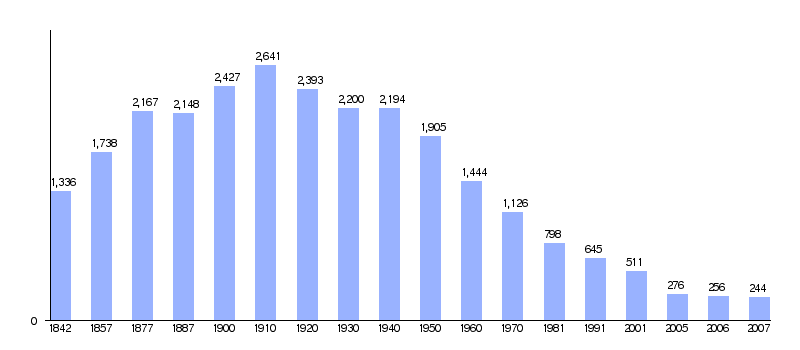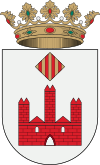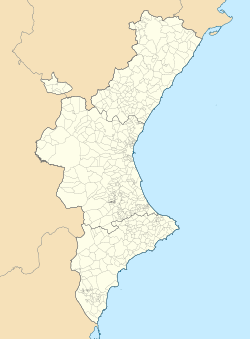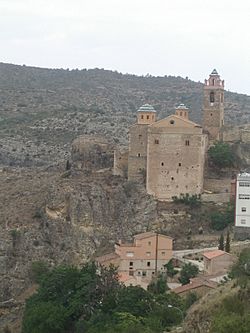Castielfabib facts for kids
Quick facts for kids
Castielfabib
|
||
|---|---|---|
 |
||
|
||
| Country | Spain | |
| Autonomous community | Valencian Community | |
| Province | Valencia | |
| Comarca | Rincón de Ademuz | |
| Judicial district | Llíria | |
| Area | ||
| • Total | 106.3 km2 (41.0 sq mi) | |
| Elevation | 927 m (3,041 ft) | |
| Population
(2018)
|
||
| • Total | 306 | |
| • Density | 2.879/km2 (7.456/sq mi) | |
| Demonym(s) | Castielero, castielera | |
| Time zone | UTC+1 (CET) | |
| • Summer (DST) | UTC+2 (CEST) | |
| Postal code |
46141
|
|
| Official language(s) | Spanish | |
Castielfabib is a small town, or municipality, in the Rincón de Ademuz region of the Valencian Community in Spain. It is known for its beautiful mountain scenery.
Contents
Exploring Castielfabib's Geography
Castielfabib is often called "the small Albarracín" because of its charming look. It sits on a hill next to the Ebrón River. This town is in the northwest part of the Rincón de Ademuz region.
Mountains and Rivers
The area around Castielfabib is very mountainous. The land rises from about 800 meters (2,625 feet) to 1,550 meters (5,085 feet) high. Some important peaks include Mill Creek (1,338 m) and Peral (1,481 m). The highest point is the Cross of the Three Kingdoms (1,552 m). This spot got its name because it used to be where the old Kingdom of Aragon, Kingdom of Castile, and Kingdom of Valencia met.
The Turia River flows from the north, forming a border with the area of Teruel. The Ebrón River also crosses the region, flowing into the Turia. The climate here is continental, meaning it has hot summers and cold winters. Winds usually come from the north and east.
Nearby Villages and Borders
Castielfabib includes several smaller villages, which are called pedanías. These are:
- Arroyo Cerezo
- Cuesta del Rato
- Mas de Jacinto
- Mas de los Mudos
- Los Santos
Castielfabib shares its borders with other towns in the province of Valencia, like Ademuz, Torrebaja, and Vallanca. It also borders towns in other Spanish provinces. To the west, it touches Salvacañete in the province of Cuenca. To the north and northeast, it borders towns like Tormón and El Cuervo in the province of Teruel.
A Look at Castielfabib's History
People have lived in the Castielfabib area for a very long time. Signs of ancient cultures, like the Bronze Age and Iron Age, have been found here. There are also remains from the Iberian people. West of the town, Faber Castle was built on top of old Roman ruins. In 1971, a piece of a Roman tombstone was discovered. It is now kept in the Museum of Prehistoric Valencia.
Medieval Times and Royal Control
In 1210, King Peter II of Aragon captured the area. However, Muslims soon took it back. Later, King James I recaptured it during the Reconquista. Castielfabib, along with Ademuz, became part of the Kingdom of Valencia. These towns were directly controlled by the king.
In 1304, Castielfabib was used as a guarantee for a loan from the Knights Templar. When this group was dissolved, their rights went to the Order of Montesa. This order collected taxes from Castielfabib and Ademuz. In 1390, the Pope even got involved in a disagreement between the Montesa order and the local bishop about religious practices. As a royal town, Castielfabib regularly sent a representative to the Generalitat Valenciana, which was like the Valencian Parliament.
Wars and Changes
During the Peninsular War in the 19th century, French forces took control of Castielfabib. Later, during the Carlist Wars (civil wars in Spain), Carlist forces occupied the town. They rebuilt the castle, but it was later destroyed when nationalist forces won it back. The town has mostly stayed the same since medieval times. Only the nearby town of Torrebaja was created from Castielfabib's original territory.
Population Changes in Castielfabib
The number of people living in Castielfabib has changed a lot over the years.
| Demographic evolution of Castielfabib since 1842 |
 |
|
|
Castielfabib's Economy
The economy of Castielfabib has traditionally relied on farming and raising animals. The local rivers provide water to grow crops like apples, pears, vegetables, and grains. In areas that depend on rain, people grow cereal and vine plants. Sheep farming is very important here, along with pigs and goats. Beekeeping, which is raising bees for honey, is also practiced.
The main road to Castielfabib is the N-420. There is a tourism office for the Rincón de Ademuz region located near the town. This area also has a rural tourism complex. There is a youth hostel with a swimming pool, offering services for visitors.
Festivals and Local Traditions
Castielfabib celebrates several interesting festivals throughout the year:
- A festival honoring Our Lady of Grace is held every year from September 7th to 11th.
- A festival for San Guillermo, who is the patron saint of Castielfabib, takes place on February 10th.
- Easter celebrations have many special traditions. On Friday, two tall poplar trees are brought from the riverbanks. On Saturday, these trees are planted in the town square. That night, there's a popular dance. Early on Sunday morning, people sing the "Aurora," and there's bell ringing and church services.
Delicious Local Cuisine
Castielfabib shares many traditional recipes with other towns in the Rincón de Ademuz region. These often feature pork and its products. Some popular dishes include gachas (a type of porridge) and puchero (a hearty stew).
Almonds, apples, and other fruits grow well in the fertile plain of the Ebrón River. These fruits are key ingredients in the local baked goods. Recently, other local products like mushrooms and tomatoes have also become popular.
Famous People from Castielfabib
- Francisco Novella (1581–1645) was a writer and a professor of rhetoric at the University of Valencia.
- Antonio Diaz Tortajada (born 1947) is a journalist and writer.
See also
 In Spanish: Castielfabib para niños
In Spanish: Castielfabib para niños





